DEFENCE Leonardo AW149
Chopper country
TIM ROBINSON FRAeS reports from Britain’s historic rotorcraft centre of excellence, Yeovil, as Leonardo pitches its AW149 for the UK’s New Medium Helicopter requirement.
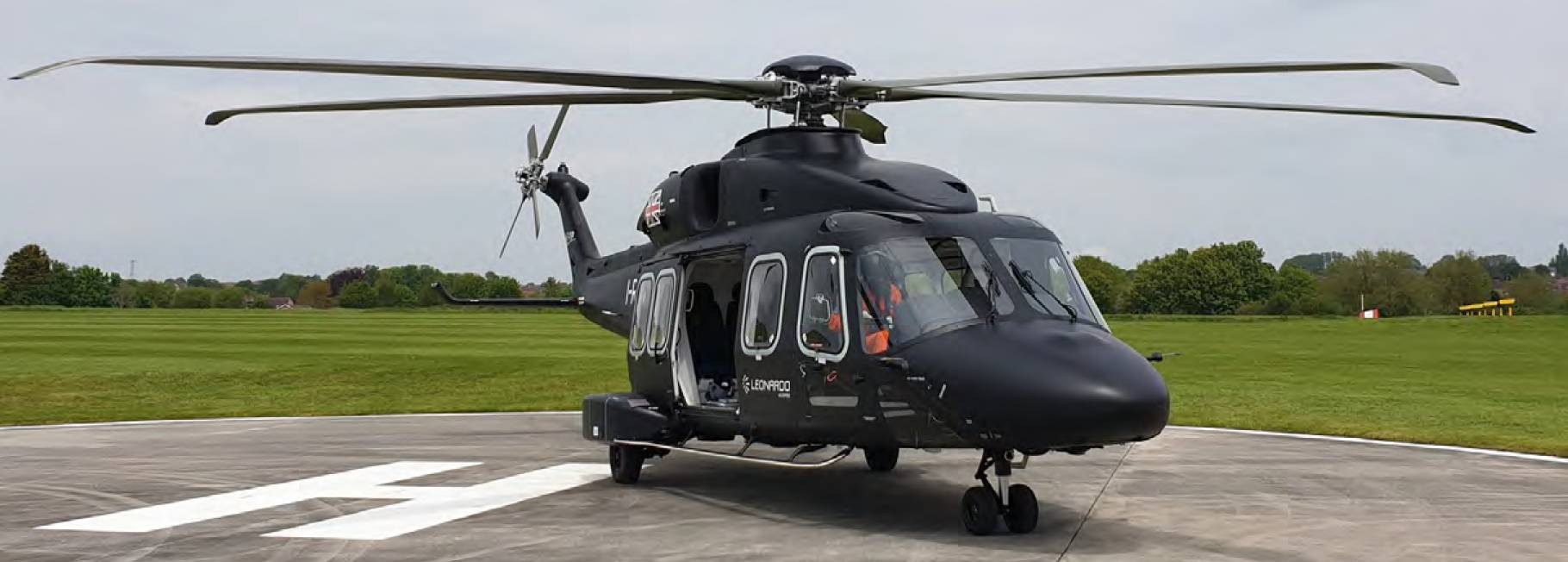 Tim Robinson/RAeS
Tim Robinson/RAeS
We are dropping down to 500ft and racing over the English countryside, in a sleek black flying machine – with the aircraft tilting first this way and then the other as the co-pilot calls to avoid flocks of curious sheep. Minutes later, we are hovering behind a treeline, in a ‘battle position’ while using the autohover to peek over the wood. I’m in the rear cabin of Leonardo’s AW149 Common Platform Demonstrator (CPD), while two of Leonardo’s senior test pilots, (Mark Burnand, Chief Test Pilot and Lee Evans, Test Pilot) put the helicopter through its paces on a short demo flight to show off the aircraft.
In flight, the main rotor being tilted forward very slightly means that the aircraft flies in a fuselage level attitude, cutting down on drag but there is no difference in visibility to be seen once in the hover.
Two things stand out immediately. Firstly – despite its size (it is a 19-seat helicopter) it is uncommonly agile for such a largish aircraft – as if there is a Lynx or Wildcat fighting to get out – a feature noted by Evans – with his background in the smaller, more agile Lynx. We barely need power reserves and the AW149 pulls impressive wingovers that would thrill an airshow crowd. With six passengers on board and 1,400kg on fuel the AW149 was able to climb at over 4,000ft per minute. In the hover too, it is safe with a single-engine, should one powerplant suddenly shut-down.
The second is the smoothness of the flight and the quietness of the cabin. True, it is only a short flight but we arrive back in Yeovil refreshed and raring for more. Longer flights, therefore, will see troops arrive with minimum fatigue from the flight itself.
The AW149 demonstrator being used by Leonardo is actually a civil AW189 company aircraft, repainted in a military colour scheme and fitted with Safran’s Aneto-1K engines. While it lacks military specific equipment, such as seat armour, EO/IR sensors, defensive aids and armament, Leonardo believes the demonstrator gives a broadly accurate view of the type’s performance, dimensions and baseline avionics fit and has been flying media, MoD officials and decision makers to inform them of its potential to meet the UK’s New Medium Helicopter (NMH) requirement.
The New Medium Helicopter
The NMH emerging requirement, as stated in this year’s Integrated Review, aims to replace the 50-year old Puma in RAF service, along with other niche mini fleets of AAC Airbus Dauphins and Bell AB212s, as well as RAF Bell 412s operated in Cyprus. This will see four types replaced with one single helicopter – covering a variety of roles from troop transport, underslung loads, special forces assault, CASEVAC/ MEDVAC and Combat SAR.
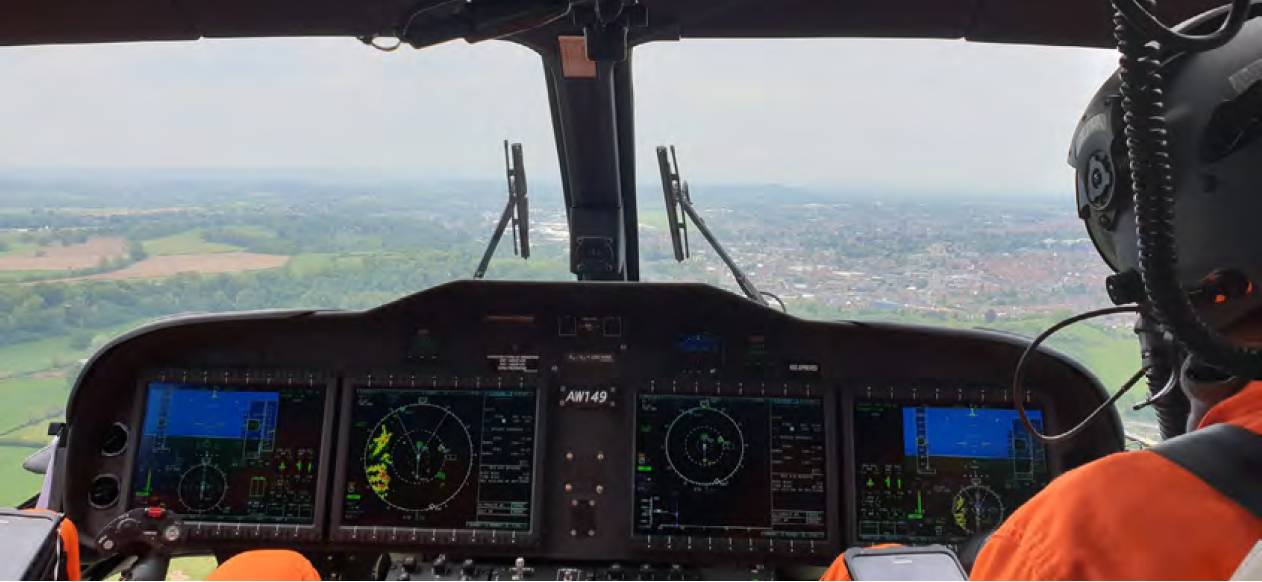 Hands-off precision approach back to Yeovil in the AW149 Common Platform Demonstrator. Tim Robinson/RAeS
Hands-off precision approach back to Yeovil in the AW149 Common Platform Demonstrator. Tim Robinson/RAeS
With the Puma out-of-service date just four years away in 2025, industry is expecting a fast decision from the MoD with around 35-40 airframes needed to replace these four fleets. Though this UK procurement is relatively small compared to the NATO Next Generation Rotorcraft Capability (NGRC) and the giant US FVL (Future Vertical Lift) progammes, it is nevertheless attracting attention as the first UK defence competition post-IR and one in which industry is keen to compete in.
Compact footprint, roomy cabin
For this, Yeovil-based Leonardo is proposing its twin-engine AW149 medium helicopter. Leonardo’s Mike Morrisroe (Head of UK Campaigns) explains the choice of the AW149 for the NMH: “We looked at those roles today and how they might progress in the future, and we looked at the AW149 and likely configurations, with mission analysis and costs. For us, the AW149 will hit the sweet spot”.
The AW149 rectifies some of the Puma’s shortcomings, with a large cabin, compact footprint and low centre of gravity, with a wide-track undercarriage. The higher centre of gravity on the Puma led to incidents (particularly on sloping terrain) where the helicopter would roll over if pilots were not careful.
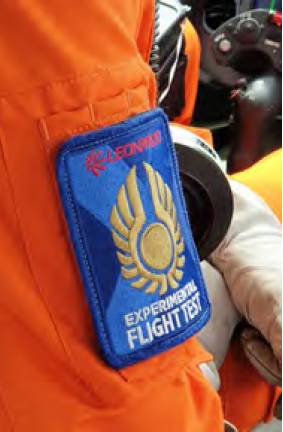 Tim Robinson/RAeSThe wide cabin features a large 11.2m3 3 space, able to fit 19 passengers or 16 fully-equipped soldiers in crashworthy seats, or four stretchers and eight seats in a medvac role – with the ability to carry a payload of 3,700+kg. There is also cabin access to a 2.4m3 3 rear stowage bay, which can be used for extra cargo, equipment or even an optional fuel tank that ups the range to 500nm. Use of this rear stowage bay for extra fuel keeps the main cabin clear of fuel. Says Mark Burnand, Chief Test Pilot: “The size of the cabin and the payload capability, for a relativity small, relativity light aircraft, speaks for itself”, adding: “You want it compact but you want it like a Tardis inside”.
Tim Robinson/RAeSThe wide cabin features a large 11.2m3 3 space, able to fit 19 passengers or 16 fully-equipped soldiers in crashworthy seats, or four stretchers and eight seats in a medvac role – with the ability to carry a payload of 3,700+kg. There is also cabin access to a 2.4m3 3 rear stowage bay, which can be used for extra cargo, equipment or even an optional fuel tank that ups the range to 500nm. Use of this rear stowage bay for extra fuel keeps the main cabin clear of fuel. Says Mark Burnand, Chief Test Pilot: “The size of the cabin and the payload capability, for a relativity small, relativity light aircraft, speaks for itself”, adding: “You want it compact but you want it like a Tardis inside”.
Its compact footprint is not just useful for confined forest clearings or urban landing zones but also in giving flexibility to potentially deploy on smaller ships. Though the AW149 is not a dedicated marine helicopter, this versatility is extremely useful given the wide range of missions that it could perform and where global Britain may be involved in the future. It is also air-transportable by C-17 or A400M.
Meanwhile, a large window behind the pilot’s seat means that a gunner can be clear of the main sliding door – important for assault landings or extractions from hot lamding zones where troops may need supporting fire from the helicopter itself, without the door gunner obstructing the main cabin door.
One unique feature are external cameras which allow the pilots to monitor loading and unloading of personnel from the cabin – aiding situational awareness when in confined spaces or on the ground and also acting as another check beyond a rear-crew member that all troops are embarked or disembarked.
Next-gen avionics
While the Puma itself received a digital cockpit refresh nearly ten years ago with the Mk2, the AW149 features the newest glass cockpit and airliner-style avionics – leveraging the latest advances in civil aerospace and the offshore helicopter sector. This is not just four large 10in x 8in screens but integrated navigation systems such as area navigation (RNAV) and performance-based navigation precision approaches to allow single pilot instrument flight rules (IFR) if need be (for example self-deploying overseas), as well as traffic collision avoidance system (TCAS) for situational awareness. This allows seamless IFR transit through civil airspace, as well as a reduced pilot workload. While performance-based navigation is common in the airline world, for many militaries this is still ‘aspirational’, says Leonardo.
THE SIZE OF THE CABIN AND THE PAYLOAD CAPABILITY, FOR A RELATIVITY SMALL, RELATIVITY LIGHT AIRCRAFT, SPEAKS FOR ITSELF.
Mark Burnand
Chief Test Pilot, Leonardo UK
Start-up is also extremely fast and automated via the enhanced control display unit (ECDU), with most time (at least for this demo flight) being spent on radios rather than flicking multiple switches across several panels. The demo flown by AEROSPACE, saw the AW149 conduct a precision approach and recover back to Yeovil on autopilot, with the pilot flying hands-off and just adjusting the speed of deceleration required – with the helicopter coming into a hover automatically.
This type of precision approach is not limited to airfields or airports either but could be a landing anywhere in the world, using GPS – providing safe, accurate approaches in all weather, day or night and allowing the crew to focus on the mission itself. While some of the avionic functions are re-used from search and rescue (SAR) and the civil world, these themselves have military applications – such as SAR search patterns or let-down in degraded visual conditions.
Says Burnand of the A149’s next-gen avionics fit: “The RNP (required navigation performance) capability to launch and recover, safely repeatedly in marginal weather conditions workload is a gamechanger”.
A fully militarised AW149 would build on these with enhanced and additional mission systems – for example by allowing a multi-function display (MFD) to display the EO/IR video imagery and a threat warning display screen.
Engine choices
The AW149 would come with a choice of two engines – either the 2,500shp Safran Aneto 1k or the 2,000shp GE CT7-2EI. While a quick comparison would suggest that the more powerful Safran turboshaft would be the obvious choice, the GE CT7 has lower fuel burn and commonality with the GE T700-GE-701D engines that power the Boeing AH64E, now entering service with the UK Army Air Corps Thus, whether extra performance (for example in hot and high conditions) or commonality and lower fuel burn is prioritised will be up to the customer. Maximum speed is 155kt while endurance is five hours.
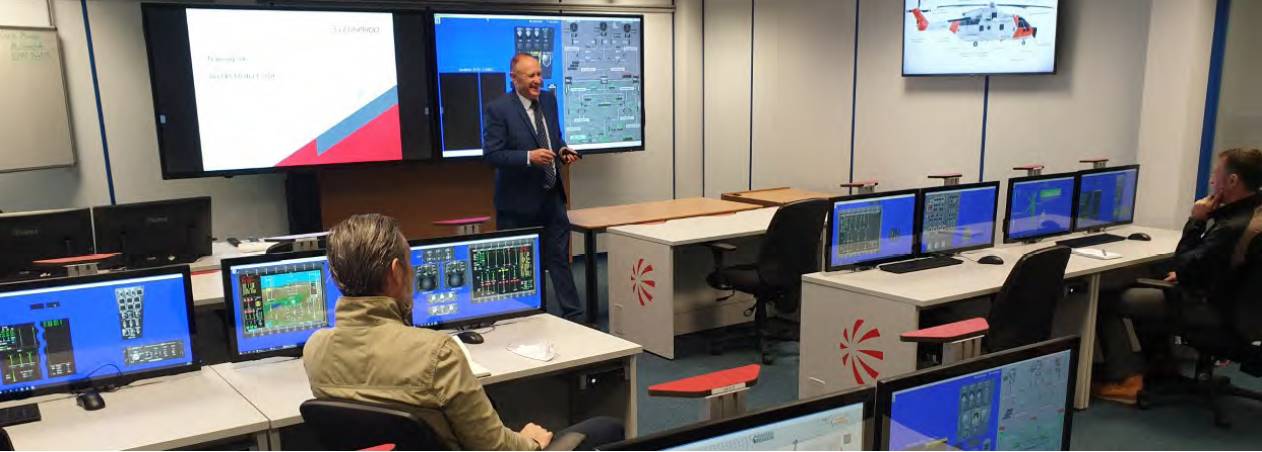 Leonardo’s state-of-the art training academy at its Yeovil site trained 3,042 students in 2020, including aircrew and maintainers despite the global pandemic. Tim Robinson/RAeS
Leonardo’s state-of-the art training academy at its Yeovil site trained 3,042 students in 2020, including aircrew and maintainers despite the global pandemic. Tim Robinson/RAeS
Optional extras
As noted previously, the CPD lacks military mission-specific kit – and getting permission to fly a rocketpod armed civilian helicopter over places such as Westminster for photoshoots, could have generated reams of paperwork and delayed Leonardo getting it in front of the right decision-makers. However there is a vast array of optional equipment that could include IR suppressed exhausts, EO/IR sensor pod, night vision goggle (NVG) compatibility, defensive aids system, flotation system, crew-served weapons, datalinks, encrypted communications and full ice and snow protection. There is also provision for fast-roping frames or a rescue winch for SAR.
Leonardo has also publicly displayed a weapon carrier ‘wing’ which could carry heavy machine guns (HMGs), rockets or even guided missiles such as MBDA’s Brimstone 2 – which would give the AW149 a fearsome punch in the assault role.
Industrial benefits
Should the AW149 be selected by the UK MoD for the NMH requirement, Leonardo says that it would establish a UK-production line for the type in Yeovil – with potential to meet additional export orders and a promise to grow the UK content to 60-70% – from the rotor blades and transmissions the company already produces in UK. Leonardo also stresses that it will not just be about sustaining existing jobs but also creating new ones, both in Yeovil and in the wider UK supply chain.
In fact, Morrisroe notes that this would be a ‘reestablished’ line, as the civil AW189 medium twin was produced in Yeovil for the UK’s SAR service, operated by Bristow on behalf on the MCA and means: “We are not starting from zero.” This previous experience on the AW189 and a hot supply chain, means that Leonardo say that, if chosen, the company could deliver a military specced but ‘off-the-shelf’ helicopter in less than 24 months. Tom Grant, AW149 UK Product Marketing Lead, says: “We are not selling a developmental aircraft. Its capability will be available by the time it’s required”.
Outside the UK, there could be further potential in the form of foreign exports, although the only military users of the AW149, at present, are Thailand and the Egyptian Navy. However, having ‘as used by HM Forces’ tagline may well be a shot in the arm to securing additional foreign sales. (It is also worth recalling that Leonardo, as well as Airbus, has been extremely successful in penetrating the US rotorcraft market with the MH-139A Grey Wolf, TH-73A and, in Airbus’ case, the UH-72 Lakota). Leonardo believes that there is minimum export potential of over 500 aircraft for the AW149 – a conservative estimate.
Other NMH contenders
Leonardo faces competition for the NMH from rival Airbus Helicopters, which is proposing a military version of its H175 twin that has been stripped of Chinese content – and which could be potentially built at its Oxford HQ. Meanwhile, Lockheed Martin UK is coy about offering its Black Hawk but says its is ‘looking carefully’ at ways it could market it to the UK MoD for NMH. A third contender may be Bell’s 525 Relentless super-medium twin helicopter.
The heart of the UK rotorcraft sector
Whitehall’s ‘levelling up’ and prosperity agenda which focuses on the UK’s regions, rather than than the prosperous SE England, should, on paper, tilt the playing field towards the historic choice of Leonardo and Yeovil in SW – a centre of excellence for rotorcraft that encompasses everything from avionics, to training, to skills and apprenticeships and MRO – as well as manufacturing.
Its helicopter training academy, for example, features the latest in computer-based conversion to type training for pilots and ‘virtual’ helicopters that allow maintainers to flick switches and see how systems operate – even before getting near the real aircraft.
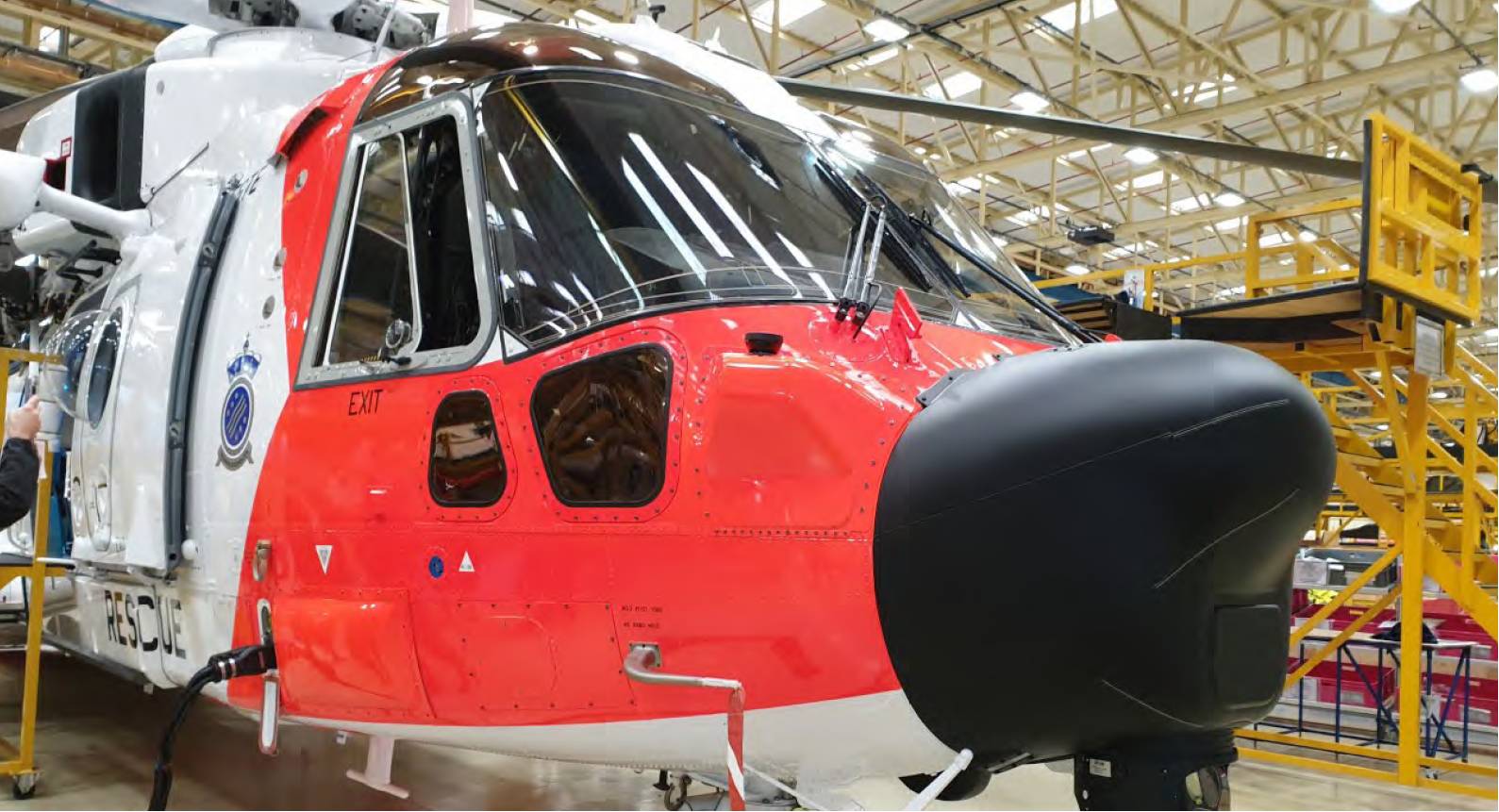 AW101 SAR for Norway on the factory floor at Yeovil. The helicopter features a custom designed navigation and terrain database and autopilot developed in house by Leonardo to allow the helicopter to hover hands-off in mountainous terrain, as well as a system that can use smartphone signals to home in on those needing rescuing and even call them in-flight. Tim Robinson/RAeS
AW101 SAR for Norway on the factory floor at Yeovil. The helicopter features a custom designed navigation and terrain database and autopilot developed in house by Leonardo to allow the helicopter to hover hands-off in mountainous terrain, as well as a system that can use smartphone signals to home in on those needing rescuing and even call them in-flight. Tim Robinson/RAeS
Yeovil also boasts its own avionics lab – where it is able, in-house, to integrate the growing number of advanced sensors, and cockpit functionality that modern multirole helicopters demand. The AW101SAR for Norway, for instance, features Leonardo’s Osprey AESA radar, EO/IR sensor and required a custom map, and digital terrain database, and a tweaked autopilot to be incorporated for Norways unique needs.
Another key facility at Yeovil is the company’s flight simulation engineering lab, where future rotorcraft cockpit designs can be demonstrated, evaluated by engineers and pilots, and refined further.
However, despite this impressive powerhouse of helicopter design, manufacture, training and support, and the IR’s stated aim to ‘onshore’ and choose military equipment built in the UK wherever possible, it would be wise for Leonardo to not get too complacent. A recent UK MoD decision saw MBDA’s Brimstone missile sidelined in favour of the US-built joint air-to-ground missile (JAGM) – reportedly on cost grounds as JAGM was already integrated with the AH-64E. There is then still all to play for in this small, yet vital, UK military helicopter procurement competition.
Summary
Whichever single type replaces the Puma and others, it will leverage some of the key technology advances in rotorcraft – particularly on the inside with nextgen avionics that have been developed for SAR and offshore customers in the past decade.
NMH may also be seen as a ‘bridge’ to the far larger, and multi-national NATO NGRC both in keeping production lines in Yeovil running but also in helping Leonardo to further craft and develop the kind of modular, affordable airborne platform, that, at one end could be a simple utility flying truck, yet at the other, a sophisticated command and control helicopter – that Europe’s armed forces may be leaning towards. Finally, NMH will also be a crucial test of the IR’s ‘Prosperity Agenda’ for the UK.
Leonardo’s test pilots themselves, with hours in previous types such as the Lynx, Wildcat and Merlin, as well as other helicopters like the Gazelle and Black Hawk, are highly enthusiastic about the potential of the AW149. Says Evans: “It’s a hugely capable aircraft”.
 Tim Robinson/RAeS
Tim Robinson/RAeS Hands-off precision approach back to Yeovil in the AW149 Common Platform Demonstrator. Tim Robinson/RAeS
Hands-off precision approach back to Yeovil in the AW149 Common Platform Demonstrator. Tim Robinson/RAeS

